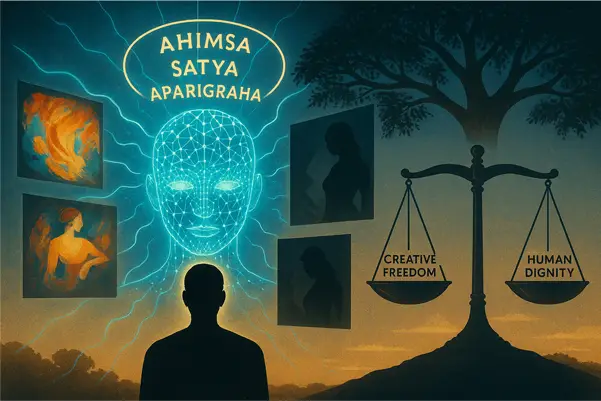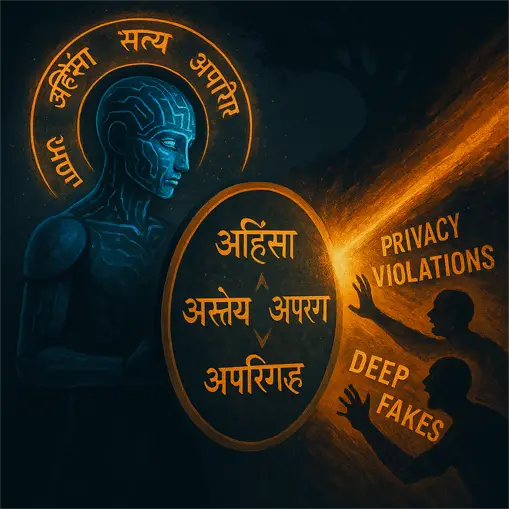Vedanta and Neural Networks: Maintaining the moral compass in realistic nude art

Generative AI models can now produce hyper-realistic nudes in seconds. This power brings new creative opportunities, but also serious ethical risks: nude AI, privacy violations, and potential harm to vulnerable individuals. In this article, we explore how core Vedantic principles - non-violence (Ahimsa), truthfulness (Satya), respect for property (Asteya), non-attachment (Aparigraha), and the moral disciplines of Yama and Niyama - can be translated into concrete safeguards for AI-driven nude art. We also outline technical measures (consent checks, watermarks, age verification, ethical audits) and organisational practices that align modern AI governance with timeless spiritual values.
Introduction: The challenge of generating realistic nudes
Advanced generative architectures (GANs, diffusion models) now produce nude images that are almost indistinguishable from mere text prompts or user photos. While this drives innovation in digital art and adult entertainment, it also creates risks: creating or sharing images without the subject's knowledge can destroy reputations and cause psychological trauma - disproportionately affecting women and minors.
Vedanta's core ethical principles

In Vedanta, Ahimsa means avoiding harm in thought, word and deed. In an AI context, it requires a zero-tolerance policy for the creation of any nude image without the explicit, informed consent of the person depicted.
Satya (Truthfulness)
Satya requires transparency and honesty. For AI art, this means clearly labelling each image as AI-generated, embedding visible watermarks, and publishing open summaries of the model's training data and methods.
Asteya and Aparigraha (Non-Theft & Non-Attachment)
Asteya prohibits the unauthorised use of the work of others; Aparigraha teaches non-attachment and respect for boundaries. Together they require platforms to use only properly licensed or public domain data, to restrict commercial distribution when privacy is at stake, and to respond quickly to takedown requests.
Yama & Niyama (moral disciplines)
The tenets of yama and niyama - purity, self-control and inner discipline - require developers to build guardrails into their services: blocking content that involves abuse or non-consensual scenarios, maintaining robust internal review processes and committing to continuous self-improvement.
The technology of realistic nudity: Power and danger
Modern GANs and diffusion pipelines handle skin textures, anatomy and dynamic lighting so convincingly that generated nudes often pass for real photographs. But with millions of free or low-cost avatar-editing tools in circulation, the potential for widespread abuse - harassment, blackmail, identity theft - has never been greater.
Ethical and legal considerations
Any nude-generation workflow must enforce "informed consent": a legally sound process (digital signatures, video verification) to ensure that subjects fully understand and consent before their likeness is altered.
Human dignity
Human dignity is non-negotiable. AI systems must be designed to avoid objectification or humiliation, in line with international guidelines that treat all people with respect.
Protect vulnerable groups
Special care is needed for minors: creating or distributing nude images of minors is illegal and causes irreparable harm. Platforms should use age verification and prohibit underage content altogether.
Embedding Vedanta in AI Nudity Practice
- Ahimsa-first design: Integrate mandatory consent checks - electronic or biometric - before any generation begins.
- Satya Transparency: Automatically tag each image with metadata and a clear watermark indicating 'AI-generated'.
- Ethical data curation: Source only openly licensed or public domain datasets and proactively purge any unlicensed material.
- Aparigraha restrictions: Define strict commercial use policies - enable topic-based removal and restrict resale of sensitive content.
- Niyama Self-Audit: Conduct quarterly ethical reviews, invite independent bug bounty hunters, and publish accountability reports.
Practical recommendations and best practices
- Draft crystal-clear terms of service that cover consent, age restrictions and takedown rights.
- Use AI detectors to flag non-consensual or harmful images and automatically block such requests.
- Provide an easy appeal process and immediate removal of content for people who haven't consented.
- Educate users about the ethical use of AI - host webinars, publish plain-language guides.
- Work with legal, religious and human rights organisations to develop industry-wide ethical standards.
By combining Vedanta's timeless ethics - Ahimsa, Satya, Asteya and Aparigraha - with contemporary AI governance, we can open new frontiers in digital art while steadfastly protecting human dignity. Implementing robust consent mechanisms, transparent labelling and regular ethical audits will ensure that AI-driven nude art flourishes responsibly, guided by both spiritual wisdom and cutting-edge best practices.




